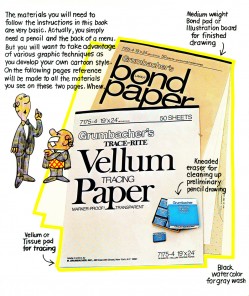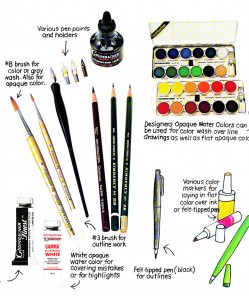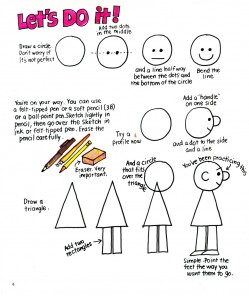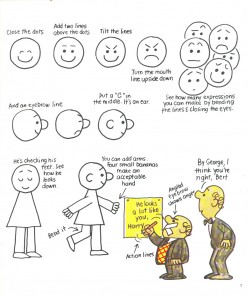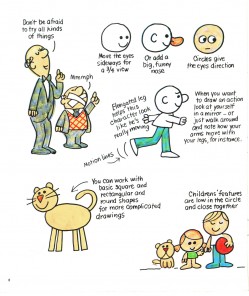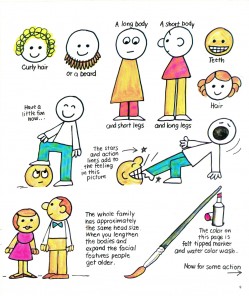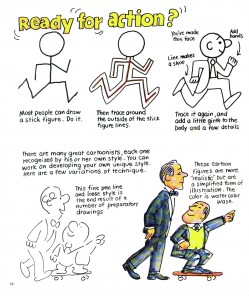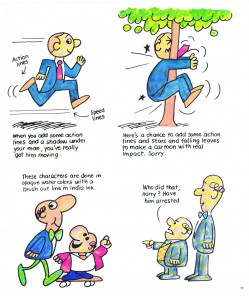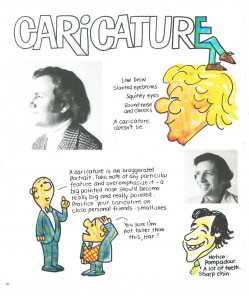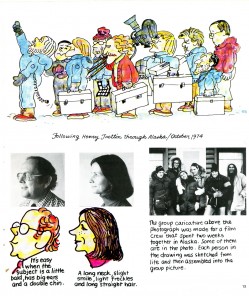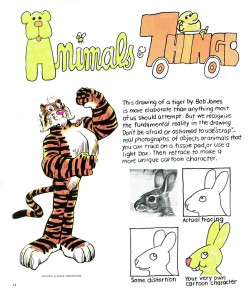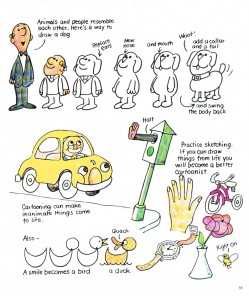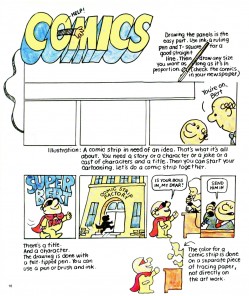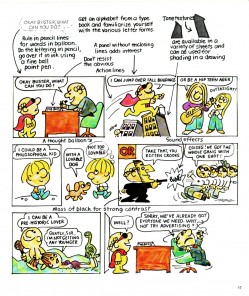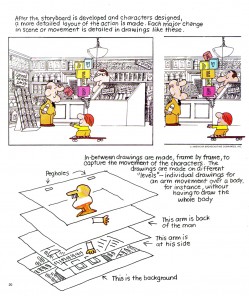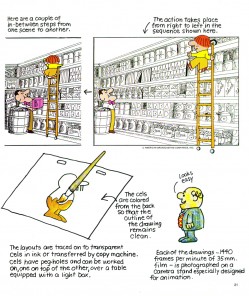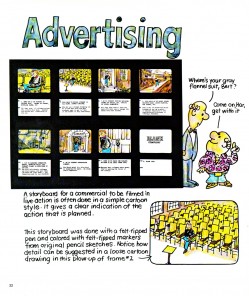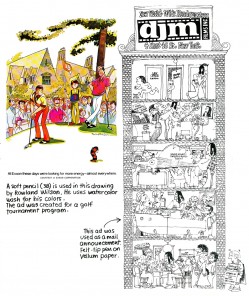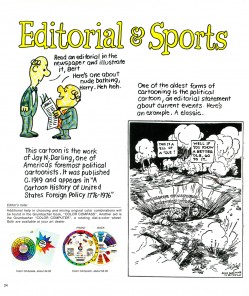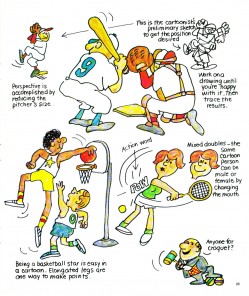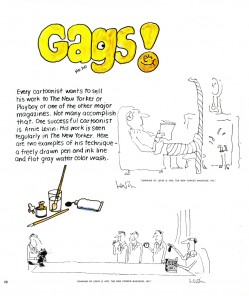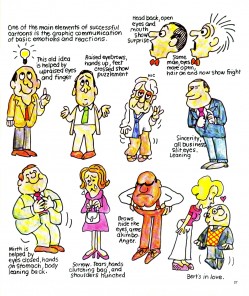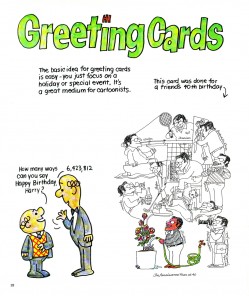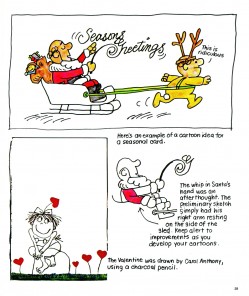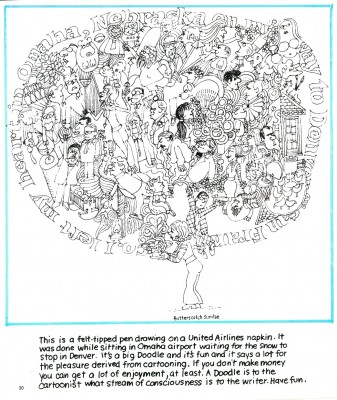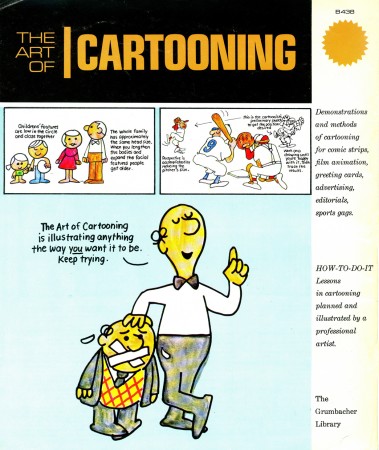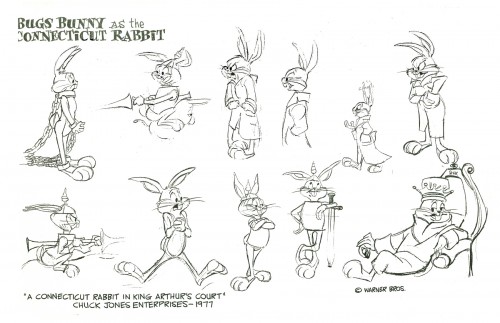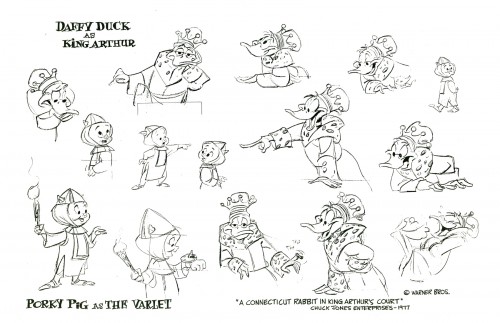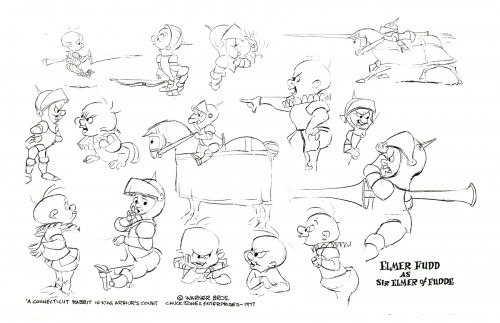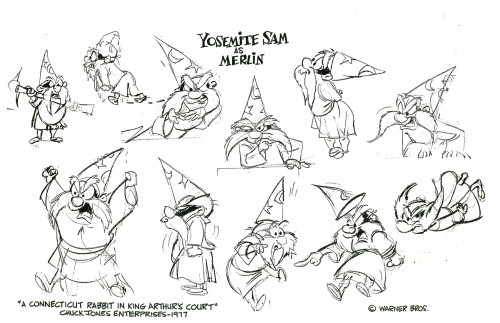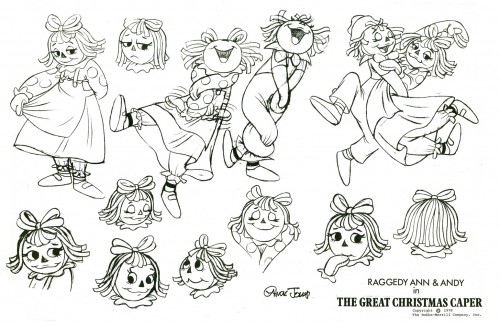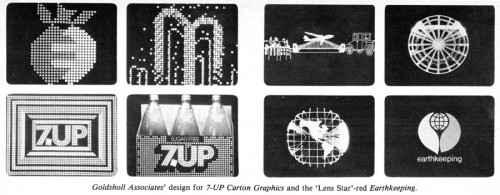Search ResultsFor "piels"
Animation &Books &Hubley &Illustration 16 Jan 2011 08:52 am
Recap – Art Director Awards ’57
Here’s a recap of one of my favorite pieces. For some reason, I get turned on by every one of these stills. Perhaps because they were printed in the Halas book which was seminal to my education about animation when I was a child – I think I had the book on permanent loan from my local library. Whatever the reason, I love looking at these pictures.
.
- I enjoy thumbing through the Art Director’s Annuals. There’s a lot of amazing illustration to view with plenty of ideas and sharp graphics on display. I have, as a good example of these hard-covered catalogues, the 1957 issue. 90% of the book is composed of illustration in the different advertising fields. A small section is devoted to TV spots and illustration. Naturally, I have a strong interest in this section.
Editorial Art, Advertising Art and Television Art all get their chapters.
Here is a pictoral list of the winners in animation for the TV commercials awards in 1957. A number of these spots have remained familiar (at least as images in old animation books – like Halas’ Technique of Film Animation.)
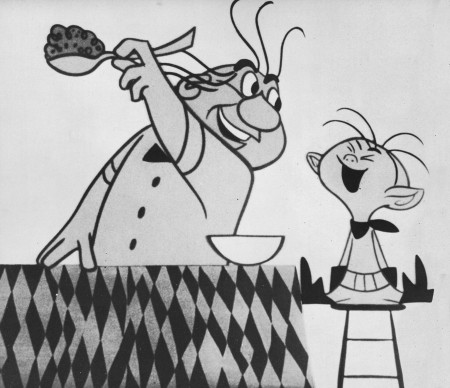
The biggest prize went to John Hubley’s Maypo commercial.
Storyboard Inc. – producer
John Hubley – Director & Art Director
Emery Hawkins – animator
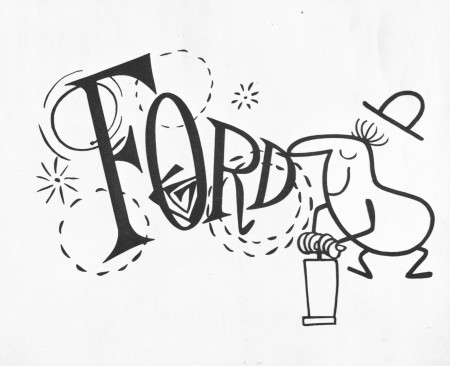
Ford commercial
Playhouse Pictures – producer
Bill Melendez – director
Sterling Sturtevant – Art Director
Bill Littlejohn – animator
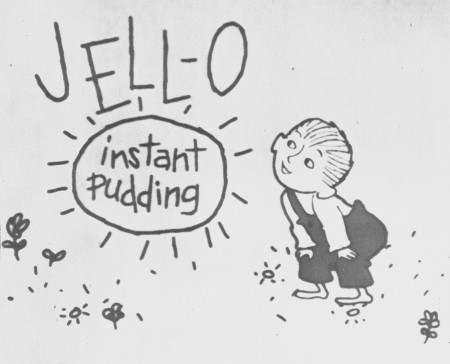
Jello
Ray Patin Productions – producer
Sonia Linker – Art Director
Maurice Sendak – artist
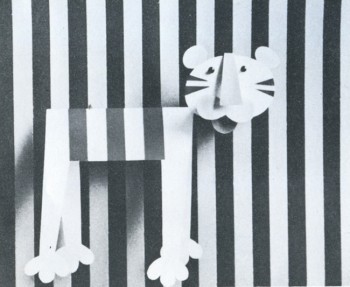
Maxwell House
Audio Productions Inc. – producer
Jerome Kuhl – artist
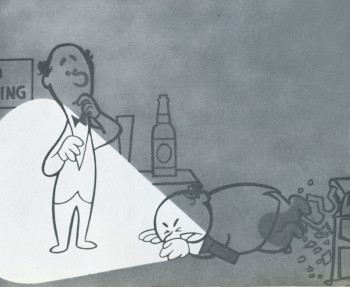
Piels Brothers Beer
UPA – producer
Jack Sidebotham – art director
Chris Ishii – designer
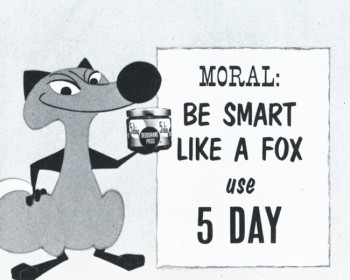
5 Day Deoderant
Storyboard Inc – producer
John Hubley – art director
Art Babbitt – animator
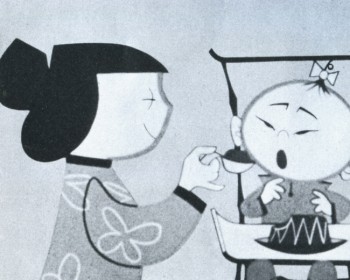
Jello Baby
Ray Patin Productions – producer
Ruchard Vab Benthem – artist
Ken Champin – photographer
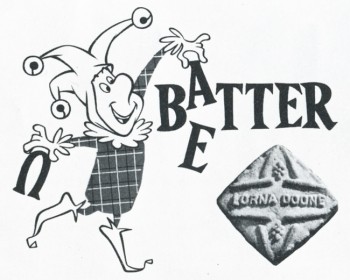
Lorna Doone
Bill Sturm Studio
Frank Broadhurst – art director
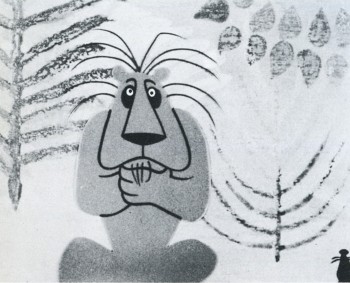
The Lion and the Mouse – Prudential
Storyboard Inc. – producer
John Hubley – director
Art Babbitt & Emery Hawkins – animation
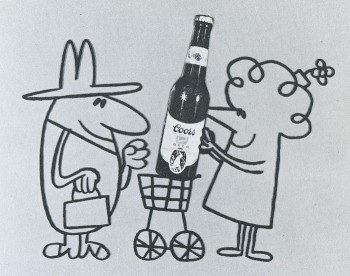
Coors Beer
UPA – producer
Jules Engel – director
Fred Crippen – art director
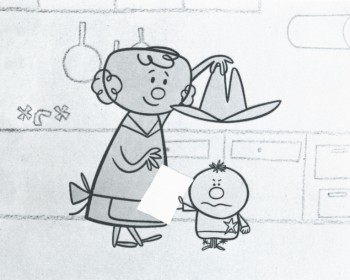
Scott Paper Co.
UPA – producer
Jack Goodford – art director
Grim Natwick, Sam Wiggenhorn – animators
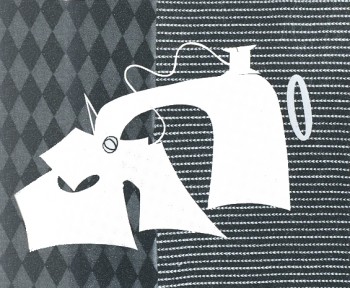
Donahue Sales Corp.
UPA – producer
Jack Goodford, Chris Ishii – art directors
Cliff Roberts – animator
Animation &Bill Peckmann &Illustration &Layout & Design &Models 17 Aug 2010 07:23 am
Jack Sidebotham 1927-2010
- Jack Sidebotham passed away on Sunday. Bill Peckmann received the following message from George Newall, the co-creator of Schoolhouse Rock:
- Sad news. Jack died last night. Evidently he and Dick Lord were having lunch when Jack complained that he thought he was having a heart attack. As it turned out, it was an aneurism. The good news is that he was in no pain and conversing with the doctor when suddenly he just wasn’t “there” anymore.
Yesterday, Jack’s niece, Kimberly Sidebotham Lennert, left this comment on my blog: “My uncle was a terrific cartoonist and had a great wit about him. I kept a box of all the little notes and drawings he sent to me. He could say a lot with a few lines and a few words. ”
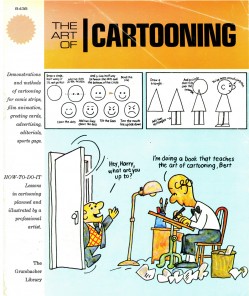 In his memory, I’ve chosen to repeat his book on Cartooning done in the 70s. Jack worked at a number of advertising agencies and had a lot to do with the Piels Brothers campaign and Scholastic Rock. He also was the agency producer for the famous Jello Chinese Baby ad done by Ray Patin Prods.
In his memory, I’ve chosen to repeat his book on Cartooning done in the 70s. Jack worked at a number of advertising agencies and had a lot to do with the Piels Brothers campaign and Scholastic Rock. He also was the agency producer for the famous Jello Chinese Baby ad done by Ray Patin Prods.
For this “Art of” book, he brings back the Piels Brothers without their great voices, comedians Bob and Ray, to escort the reader through a few lessons in cartooning and a sample of a number of different jobs in the field.
I think the book was originally published by Grumbacher, along with several others on art and painting techniques, to compete with the cheap and successful books published Walter T. Foster. They were all sold in art stores for very little money, and if you hit on a Preston Blair book, you’d found gold.
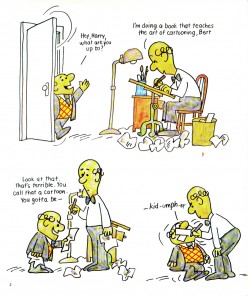 1
1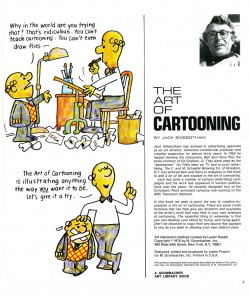 2
2(Click any image to enlarge.)
.
Articles on Animation 01 Jul 2010 08:02 am
Commercials History
- Earlier this week, I’d posted an excellent piece by Mike Barrier on the work of the Hubleys. This article was taken from a 1977 Millimeter Magazine animation issue. In that same issue, is an article about the history of the TV commercial. There’s a lot of good information in the piece and the shortened history of a lot of important studios that many of you are unfamiliar with. Unfortunately, it also mentions a lot of ads you may not be familiar with. But there’s plenty there in the packed piece. So I thought it a good idea to put this info out there.
Here’s the piece by Arthur Ross.
A Retrospective View
by Arthur Ross
ANIMATE, according to the time-honored Webster’s definition, means “to give natural life to; to give spirit to; to stimulate; to rouse; to prompt; to impart an appearance of life, as to animate a cartoon.”
And that is exactly what animated TV commercials have been doing for the past 30 years. They have given life, spirit, and verve to the selling of thousands of products both in America and abroad.
Psychologically speaking, they work by expanding the fixed limits of reality, by creating new and exciting worlds of fun and fantasy, and by captivating the viewer with fresh perspectives that reinforce our basic drives and motivations for love, success, beauty, comfort, and self-esteem.
During the course of a single 60 second spot, we see 1,440 individual pictures, or frames, come to life! Often with the kind of humor, or whimsy, or charm that speaks to our unguarded and childlike selves, and in some instances, even to the deepest recesses of our unconscious.
That is precisely why they are so potent a sales tool for industry, an educational device for schools, and an entertainment vehicle unto themselves. They work by playfulness, destroying all logical opposition to the messages they may contain.
They dazzle our senses and charm us into belief. Or, at least, they help suspend our disbelief in the ideas they put forth. They are 20th century dreams — dreams that money can buy!
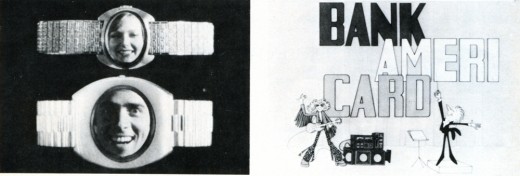
1. Object Animation: Speidel’s “Faces In The Watches”
created by John Gati of Action Pictures.
2. West Coast animation: Bank Americard (FilmFair) 1961-1976
While they operate on our most primative emotional level, animated commercials are highly sophisticated forms of art — employing words, graphics, color, motion, sound, music and symbols to activate the sale of goods and services.
Some of America’s foremost art talent has worked in the field at one time or another, including Saul Steinberg, John Hubley, William Steig, Saul Bass, to name a few.
The earliest animation in the forties was generally quite conventional — literally cartoon commercials of the straight Disney school of animation. It was essentially an extension of theatrical animation such as characterized the products of Warner Brothers, Paramount, MGM, and Disney at the time. Its novelty was successful and proved animated characters could sell products as well as live spokespeople. Everything was executed in glorious black and white, since color on TV was still years away. Commercial studios began to emerge in the late ’40s and early ’50s to supply the demand for animated spots — among them Academy Pictures, Shamus Culhane, Bill Sturm Studios, Film Graphics turning out such early “hall of famers” as the Ajax “Down the Drain” Bubbles and Mott’s “Singing Apples”.
In the early “50s a new trend entered TV commercials when UPA, creators of Gerald McBoing-Boing for theaters, introduced its unique avant-garde style of animation breaking away from the more conventional school of Disney design and execution.
We had the pleasure in the early ’50s of working personally1 with ex-UPA star John Hubley on some of the most successful of these avant-garde spots, including those for Speedway 79 gasoline, Altes Golden Lager Beer and Faygo Beverages (for the W.B. Doner agency in Detroit) as well as Chevrolet (for Campbell-Ewald, again in Detroit.) Other notable avant-garde entries during this period included the famous Saul Steinberg Jello “Busy Day” spot, as well as the classic Bert and Harry Piels spots (for Young and Rubicam).
Continuing through the mid ’50s, two trend-setting studios emerged when John Hubley formed Storyboard Inc. and Abe Liss joined forces with Sam Magdoff to start Elektra Films. Hubley continued his classic style with such winners as Heinz Worcestershire Sauce’s “Tongue-tied Spokesman”, Ford “It’s a Ford” series, and Maypo’s “I Want My Maypo” commercial. Elektra came forth with highly experimental works, creating new breakthroughs in photo-animation, multiple image and optical effects, and totally fresh avenues of design. During this time Elektra spawned such outstanding animation and graphics talents as Jack Goodford, Pable Ferro, Cliff Roberts, the Canattas, Lee Savage, Phil Kimmelman, and Hal Silvermintz, as well as Arnie Levin, Howard Beckerman, and Mordi Gerstein. Among the outstanding Elektra efforts of this era were the NBC Peacock, the legendary “Talking Stomachs” Alka Seltzer spot designed by R.O. Blechman, as well as award-winners for Chevron, Esso, Chevrolet, and Alcoa. One notable achievement, I fondly recall, was a 60-second spot done for the United States Army “Great Moments” series (which I had the pleasure of writing and producing) in which Elektra’s people (including the late Len Appleson) recreated the entire Louis-Schmelling Championship fight with stills quick-cut to the rapid beat of music and crowd cheers. It was a montage breakthrough that Sergei Eisenstein would have been proud of.
Following the success of Storyboard, Inc. and Elektra, more top studies and talent emerged in commercial animation. Pelican films emerged under the able leadership of Jack Zander and did notable work for American Motors, Volvo (designed by Mordi Gerstein) and Alka Seltzer (“The Blahs” designed by cartoonist Willilam Steig.)
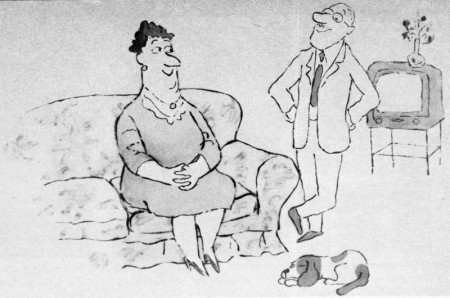
Use of famous cartoonists and illustrators in TV Commercials:
Still from a commercial made in the 60s by Elektra Productions,
utilizing cartoonist Bill Steig.
Other fine studios of the fifties were those begun by Lars Calonius, Transfilm, Kim-Gifford, Robert Lawrence and Ernest Pintoff — the latter going on to win an Academy Award for “The Critic” some years later. Arnold Stone was a heavy contributor in those years to the Pintoff output, which included excellent animated spots for Proctor-Silex appliances, Yoo-Hoo Chocolate Drink, and The Bell Telephone Company.
These proved to be the “golden years” for commercial animation with many studios maintaining large staffs to cover the growing need for their excellent product. At one point, there was even a shortage of talent available to handle the work load and one had to “wait on line” for delivery.
In the ’60s, the trend increased towards graphics and we saw a sharp decline in traditional animation. New techniques were perfected — like the super quick cuts of Elektra and Ferro, Mogubgub and Schwartz. The latter also held the industry in marvelous disbelief at its outrageously “insane comic inventions” such as the award-winning “Crazy Hat” commercial for County Fair Bread (which we had the pleasure of producing with them).
Continuing the trend to more limited animation, which UPA orginated as an economical move to cope with the high cost of full animation, studios in the ’60s experimented with photomatics, “squeeze”, semi-abstracts, paper sculpture, and technique of combining live photos with animated bodies (perfected by Paul Kim of Kim-Gifford in a prize winner for the National Safety Council on preventing highway accidents.) Tighter budgets, a declining economy, and a swing away from animation to greater use of realism created massive layoffs in the commercial animation field in the late ’60s and early ’70s — and many good, long-established shops passed from the scene. Smaller one and two-man companies emerged to take their place and this trend continues up to the present day.
It should be pointed out that throughout the ’50s and into the ’60s traditional animation continued as a popular communications tool for many agencies and companies. Outstanding among these was William Tytla Associates. The late Bill Tytla was one of the foremost Disney animators, contributing greatly to the success of such Disney immortals as FANTASIA, PINOCCHIO, SNOW WHITE and DUMBO. In the ’50s, Bill took his talents into the commercial arena and did some outstanding work in the more conventional animation forms. We had the pleasure of working with him in the animation development of the worldwide symbol for Esso, “Happy the Oil Drop,” a fantasy figure that Bill brought to wondrous “life” through his skills as an animation director.
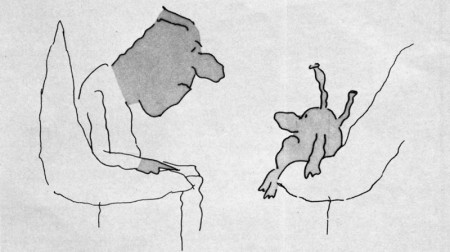
Simplicity of design in 50s & 60s; Still frame from the famous Blechman
“Talking Stomach” Alka Seltzer commercial produced by Elektra in the 60s.
In spite of downtrends in the economy, the late ’60s and early ’70s saw a brilliant new bursting forth of creative energy in animation influenced by Peter Max and the worldwide success of “The Yellow Submarine.”
Among the many fine companies that emerged were Focus Productions, which turned out such award-winners as Vote Toothpaste “Dragon Mouth,” designed by Rowland Wilson; Gillette’s “Moveable Features,” designed by Tomi Ungerer, and the Utica Club Beer series designed by Jack Davis and Mort Drucker. In 1972, Phil Kimmelman left Focus to open his own shop, Phil Kimmelman & Associates. Here, along with Bill Peckman, he has turned out some outstanding efforts including the Cheetos Mouse campaign, the Exxon Tiger, and the delicately sensuous Clairol Herbal Essence commercial.
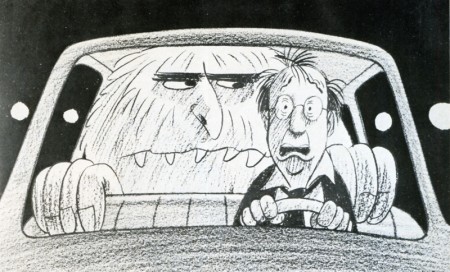
Horror Fantasy in TV commercial animation (1976): Avis Rent-A-Car;
Designer/Director: Mordi Gerstein; Producer Phil Kimmelman & Associates.
Other exciting breakthroughs in the ’70s include the highly graphic look of computer animation, perfected by such companies as Dolphin Productions for use as station and program attractions; rotoscope animation brought to brilliant maturity by Ovation Films in New York and Snazelle Films on the West Coast. The Levi campaign is an outstanding example of rotoscope animation, bringing a fresh new excitement to the field.
On the West Coast, throughout the ’50s and ’60s animation led by UP A, and Storyboard, Inc., continued to expand along with the fine efforts of such companies as TV Spots for Johnson’s Wax, Lucky Lager Beer and L&M Cigarettes; John Sutherland Productions (“A 1580 Atom”); Playhouse Pictures (Ford, Falstaff Beer, H.J. Heinz) Quartet Films (Western Airlines); Animation, Inc. for Oscar Mayer, Soho Boron Gasoline and Pabst Blue Ribbon Beer; and Five Star Productions whose animation department headed by Howard Swift (another ex-Disney man) created some of the earlier TV and cinema commercials for Ford, Pabst, F.T.D., Coca-Cola, as well as bringing Speedy Alka-Seltzer to “life” via the George Pal puppet-type stop motion use of a series of replaceable heads. Interestingly, after a decade of experimenting with other creative directions, Alka Seltzer has just reverted back to using “Speedy” again in its current advertising.
It is an outstanding example of how things come creatively full-circle and how each generation rediscovers the “great ideas” of the past.
Joop Geesink continued to perfect the puppet type animation throughout the fifties, working in Holland for American companies through Transfilm in the United States. His “Brewster, the Goebel Rooster” and Heinz Aristocrat Tomato were two fine creations in this genre.
The use of “stylized” animation-type settings in which live action unfolds was another outgrowth of animation in the late ’50s. S. Rollins Guild whom we had the pleasure of working with at McCann-Erickson in the ’60s contributed greatly to the perfection of this commercial art form for such companies as Nabisco and Coca-Cola. Both series were produced by Bill Sturm Productions in New York.
Black-Lite, while basically a live photographic technique, creates a unique “animation” look to commercials. We had the opportunity of creating and producing the first such black-lite commercial in 1955 for Flagg Brothers Shoes (“Dancing Shoes”) which won numerous Art Director Club Awards for originality and effectiveness. The producing company was Sundial Films, headed by the multi-talented Sam Datlowe. It marked the first commercial assignment for young and talented Jerry Hirshfeld, who later became the ace of the MPO Productions staff, before turning to feature films.
One of the continuing trends in animation today, largely aided by Elektra and Jack Zander in the ’50s, is the use of well-known cartoonists and illustrators from outside the industry. Among the best are Bill Steig, Frank Modell, Charles Saxon, Seymour Chwast, Milton Glaser, and Peter Max, all contributing greatly to the resurgence of animation in the “70s.
Other outstanding work in animated commercials was achieved on the West Coast by Ray Patin, whose chief animator (another Disney graduate) was Gus Jekel, now the head of Film Fair, Inc. They accomplished some fine efforts for Y&R on Jello in the early ’50s through Jack Sidebotham, one of the really great art directors in the advertising field. These include such classics as “Banana-ana,” and “Chinese Baby.” Ray Patin also turned out the NY AD gold medal Bardahl series, aping Dragnet, as well as noteworthy campaigns for National Bohemian Beer and Jax Beer.
In passing, one must not forget to include in the pantheon of animation producers such fine organizations as Cascade Productions, Playhouse Pictures, Quartet, Imagination, Inc. all of whom executed award-winning series in the ’50s and ’60s.
In the ’60s, Gus Jekel’s Film Fair did noteworthy series for BankAmericard and Bardahl which won the Cannes and Venice Awards. Today, Film Fair does exceptional work with continuing characters, such as Peter Pan (Peanut Butter). Charlie Tuna, Tony Tiger, and the Snap, Crackle and Pop trio for Kellogg’s Like Elektra in the East, Film Fair nurtured a great deal of the best West Coast talent including Art Babbitt, Bob Cannon, Dick Van Benthem, Ken Walker, Fred Wolf, Norm Gottfredson, Ken Champin, and Corny Cole. It is one of the reasons the West Coast continues to do such exciting creative work in the field along with its East Coast counterparts.
One of the long-standing successful animation partnerships in the East has been Paul Kim and Lew Gifford, doing fine work in the field since 1958. Among their top creative efforts are award-winners for Piels Brothers, and the Emily Tipp series. Their Modess a delicate subject with taste, simplicity, and artistry. And their famous Winston “Montage” introduced a 14 way split screen in constant movement to the Winston jingle — breaking exciting new ground in the use of matte work and animation design.
Another top West Coaster is veteran animator Herbert Klynn, President of Format Productions. Herb served 16 years as designer and then Executive Production Manager for UPA, before organizing his own animation company. His Format Productions is active in entertainment series such as the Alvin Shows, the Lone Ranger and Popeye programs, as well as creating titles for such TV shows as I Spy, Smothers Brothers, and The Mothers-In-Law. Among his fine animated TV commercials are those for Max Factor, Post Cereals, Wells Fargo Bank, and Dreyfus Investments. During his tenure with UPA, Herb worked on such classic film cartoon short subjects as “Madeline,” “Mister Magoo,” and “Gerald McBoing-Boing.” Our own particular favorite is his treatment of Poe’s “The Tell-Tale Heart” for UPA.
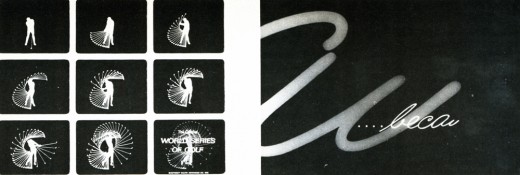
1. Graphic animation of a “strobe” like image of a golfer, made with 90 kodalith negatives
in registration. (World Series of Golf” Show opening by Goldsholl Associates.
2. The Unspoken Spoken Message: Modess “Because” (1962) Kim & Gifford Productions
Some fine animation has come out of the Midwest, too, in recent years. A key contributer from that area is Goldsholl Associates, an Illinois-based house that has brought fresh innovative graphics and experimental style to animated TV spots. In such commercials as 7-UP’s Sugar-Free “Carton Graphics” they infuse “life” into abstract dots to create a rich new imagery on screen. Colors, shapes, and textures all impart a “meaning” experi-entally to the message.
One of the more prolific of New York’s animators is Jack Zander. He began his career in 1946 at Willard Pictures doing an animated Chiclets commercial in which he animated Chiclets’ boxes like a choo-choo train to a music track taken off a 78 rpm radio transcription. In 1948, he started up the animation department at Transfilm, where he created the first animated Camel Cigarette commercials and helped develop the paper “cut-out” technique. In 1954 he and Joe Dunford opened Pelican Films and did successful commercials for over 16 years, along with Mordi Gerstein, Lars Colonius, Paul Harvey, Wayne Becher and Dino Kata-polis. During this period, Jack utilized the service of several wellknown cartoonists, including Charles Saxon for American Airlines, and later Bill Steig and George Price of “New Yorker” fame. It was also during this period that Jack did the famous Nichols and May “Jax Beer” animated series, as well as some of the early Bert and Harry Piels spots.
In 1970, Jack moved across the street and launched Zander’s Animation Parlor with his son Mark. He has created his share of “hits” in recent years, too, including the exceptionally fine Freakies campaign, beautifully animated by Preston Blair.
Another fine New York animation talent is Art Petricone who today heads up Ovation Films. In addition to his fine work for Eastern Airlines, his brilliant use of rotoscope can be seen in his work for Levi Strauss and Clairol Herbalessence.
In the area of object and figure animation and stop motion, John Gati, the Director of Special Effects, for Action Pictures in New York is unsurpassed. John has been working at his craft for 26 years and has won many awards for technique and innovation.
The art of Object and Figure Animation requires enormous craftsmanship. Basically, it resembles conventional (drawn) animation in that it follows the rule of “creating the movement” by the process of frame by frame photography. But as opposed to eel animation, which occurs on a two dimensional (acetate) surface, Object Animation is similar to live action photography taking place in a three-dimensional area.
John Gati’s creations succeed in making the product itself (the object) become the hero of the commercial, which is one of the basic tenets of good “sell” advertising. Complicated rigs and special dimensional lighting are required to make this form of animation truly work. It requires enormous intricacy to sustain the fantasy of “life” for these objects. John works with such materials as foams, wires, rubbers, vinyls, plastics, silks, clays and waxes to create the illusion of “reality.” Working in the tradition of the great artists and artisans of the past, John — like McLaren and Trnka and Geesink — has created a wondrous world of living and moving objects that reflect a “life all their own. Among his most recent successes are Fleischman’s “Egg Beaters” and Speidel’s “Faces In the Watch-bands. ”
In passing, we would also like to salute the following fine practioners of the art: Snazelle Films and Kurtz and Friends for their fine Levis efforts; Bill Melendez (Bill Melendez Productions); Hal Silvermintz (Perpetual Motion); Carlos Sanchez (IF Studios); William Littlejohn (William Littlejohn Productions); and Art Babbitt (Hanna-Barbera Commercials.)
The boundaries of animation are limitless. They defy time and space. They fuse reality with fantasy. They create new life out of old forms. Most animators believe the future will see the development of completely new and exciting techniques for the art. More use of famous illustrators and designers from the non-animation world. New developments in computer animation. More combinations of live action and animation within the same frame. More sophisticated “selling” within the framework of fantasy and humor. New breakthroughs in stop motion object animation. Fresh combinations of tape and film in animation. Unusual variations on dimensional and multi-plane animation effects.
For the most part animators strongly feel animation commercials can achieve greater results than live action, because “they can be funnier and they can be controlled absolutely” (Lee Savage); “You can get information across quicker” (Bob Godfrey);” ” “Animation makes an incredible statement real… In animation, sweeping moves are totally acceptable as opposed to the heaviness of human action (Mort Goldsholl).”
What is evident, too, is that small teams are creating the most significant new work in animation today. While the Disneys and Hanna-Barberas continue to produce a great volume of praise-worthy animation for film and TV, the breakthroughs are, for the most part, coming from the isolated artists and small creative teams working throughout the country.
And bridging the gap between these artists and the advertising agencies are producers like Harold Friedman of The Directors Circle, who fully understand the needs of both parties for creative expression, on the one hand, and sound selling messages, on the other. In the final analysis, an animated commercial to be successful must motivate the consumer to buy the product, or the service, or the idea put forth by the commercial. That is its major raison d’etre. It should be charming, to be sure, and filled with fun and fantasy — but it must ultimately sell its clients’ products in the marketplace to achieve its truest objectives.
Bill Peckmann &Books 06 Mar 2010 08:46 am
Cartooning – 2
 - It seems like ages ago that I posted the first half of this book. It was written by art director/designer, Jack Sidebotham who had a large presence in the making of the original Piels Bros. campaign done by UPA NY. He also was closely involved with the Scholastic Rock films.
- It seems like ages ago that I posted the first half of this book. It was written by art director/designer, Jack Sidebotham who had a large presence in the making of the original Piels Bros. campaign done by UPA NY. He also was closely involved with the Scholastic Rock films.
As mentioned in the first post, Sidebotham used the Piels Brothers as characters to waltz through the varied uses of cartooning for this book published by Graumbacher in the 70s.
The book was something I remembered from the period but never purchased for myself. When Bill Peckmann reminded me of its existence, I found a copy on line and bought it to add to my collection and to share with you.
This second half of the book covers the aspects of cartooning that might be more interesting to an audience of animatoin fans. Here it is:
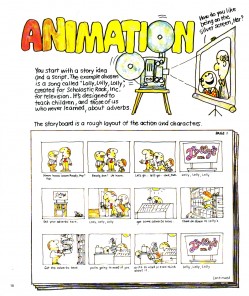 18
18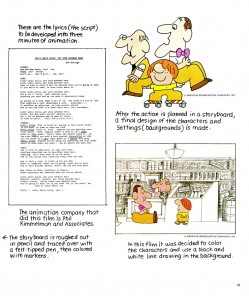 19
19(Click any image to enlarge and read.)
.
Bill Peckmann &Books 20 Feb 2010 09:24 am
Cartooning – 1
 - Bill Peckmann reminded me of a “how to” book that was published in the ’70s called, “The Art of Cartooning.” It was written by art director/designer, Jack Sidebotham. He worked at a number of agencies and had a lot to do with the Piels Brothers and Scholastic Rock.
- Bill Peckmann reminded me of a “how to” book that was published in the ’70s called, “The Art of Cartooning.” It was written by art director/designer, Jack Sidebotham. He worked at a number of agencies and had a lot to do with the Piels Brothers and Scholastic Rock.
For this “Art of” book, he brings back the Piels Brothers without the wit and charm of their great voices, comedians Bob and Ray, to escort the reader through a few lessons in cartooning and a sample of a number of different jobs in the field.
I think the book was originally published by Grumbacher, along with several others on art and painting techniques, to compete with the cheap and successful books published Walter T. Foster. They were all sold in art stores for very little money, and if you hit on a Preston Blair book, you’d found gold.
here’s the first half of the book. Next week, I’ll start with the four-page chapter on animation.
 1
1  2
2(Click any image to enlarge.)
Animation Artifacts &Bill Peckmann &Chuck Jones &Models 27 Jan 2010 09:47 am
Assorted Models
- As I’ve said in the past, I just love model sheets. And here are a stash of them on loan from Bill Peckmann‘s collection. Some good, some not-so-good, and some great.
Let’s start off with something great.
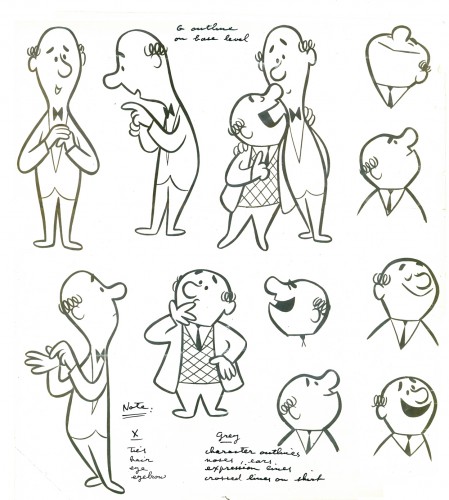
Bert and Harry Piels in a photostat
from the UPA studio.
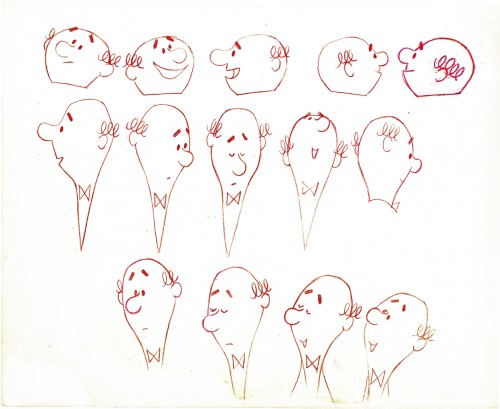
Here’s a head model for the Piels brothers
drawn in red colerase on animation bond.
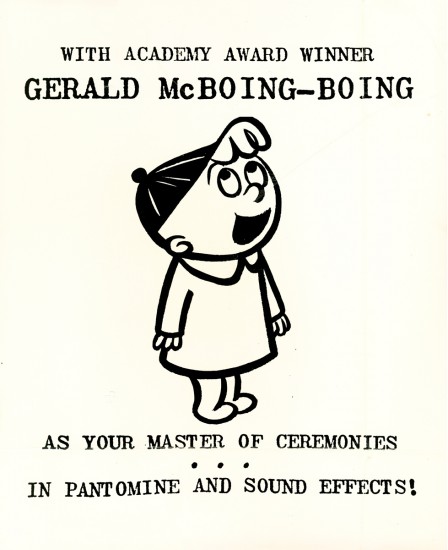
Here’s a B&W fading photostat of an announcement
for the Gerald McBoing Boing Show direct from UPA.
The following are some models from Chuck Jones’ not-so-good tv film
A Connecticut Rabbit in King Arthur’s Court.
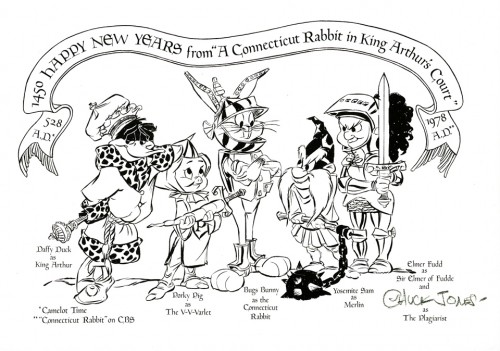
Here’s a HAPPY NEW YEAR card from 1978.
Finally the bottom of the barrel of a couple of models
from Chuck Jones’ RAGGEDY ANN & ANDY in
The Great Christmas Caper.
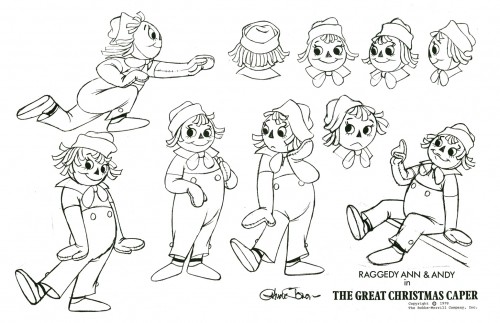
The characters never looked worse.
In his later years, Chuck reworked the WB characters into something
godawful, and here he takes Raggedy Ann and Andy way over that
cute/corny/ugly line. Too bad he didn’t pull Corny Cole into it.
Books &Photos 18 Oct 2009 08:12 am
Art Director Awards ’57
- I enjoy thumbing through the Art Director’s Annuals. There’s a lot of amazing illustration to view with plenty of ideas and sharp graphics on display. I have, as a good example of these hard-covered catalogues, the 1957 issue. 90% of the book is composed of illustration in the different advertising fields. A small section is devoted to TV spots and illustration. Naturally, I have a strong interest in this section.
Editorial Art, Advertising Art and Television Art all get their chapters.
Here is a pictoral list of the winners in animation for the TV commercials awards in 1957. A number of these spots have remained familiar (at least as images in old animation books – like Halas’ Technique of Film Animation.)

The biggest prize went to John Hubley’s Maypo commercial.
Storyboard Inc. – producer
John Hubley – Director & Art Director
Emery Hawkins – animator

Ford commercial
Playhouse Pictures – producer
Bill Melendez – director
Sterling Sturtevant – Art Director
Bill Littlejohn – animator

Jello
Ray Patin Productions – producer
Sonia Linker – Art Director
Maurice Sendak – artist

Maxwell House
Audio Productions Inc. – producer
Jerome Kuhl – artist

Piels Brothers Beer
UPA – producer
Jack Sidebotham – art director
Chris Ishii – designer

5 Day Deoderant
Storyboard Inc – producer
John Hubley – art director
Art Babbitt – animator

Jello Baby
Ray Patin Productions – producer
Ruchard Vab Benthem – artist
Ken Champin – photographer

Lorna Doone
Bill Sturm Studio
Frank Broadhurst – art director

The Lion and the Mouse – Prudential
Storyboard Inc. – producer
John Hubley – director
Art Babbitt & Emery Hawkins – animation

Coors Beer
UPA – producer
Jules Engel – director
Fred Crippen – art director

Scott Paper Co.
UPA – producer
Jack Goodford – art director
Grim Natwick, Sam Wiggenhorn – animators

Donahue Sales Corp.
UPA – producer
Jack Goodford, Chris Ishii – art directors
Cliff Roberts – animator
Articles on Animation 18 Dec 2008 09:07 am
Spots – 1976
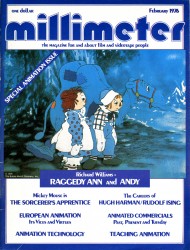 - Back in 1976 John Canemaker asked if I was interested in writing a piece on commercial studios for Millimeter Magazine. I was interested and took the job (while at the same time working at the Raggedy Ann studio.)
- Back in 1976 John Canemaker asked if I was interested in writing a piece on commercial studios for Millimeter Magazine. I was interested and took the job (while at the same time working at the Raggedy Ann studio.)
I found that commercial production was on a downswing and theatrical production up, keeping a lot of the smaller studios operating. That became my thesis for the piece, and I got in trouble for speaking my mind. One producer I praised said I was on his “s##t list” and I didn’t have to bother applying at his studio for a job. Since I had never sought work in his company, I found the thought amusing but was still confused that he’d found my article bothersome.
Looking back on the article now, I see that it was much ado about nothing; the article is and was harmless. However, it does give an overview of the commercial world – particularly in New York. Hence, I thought I’d entertain myself by posting it.
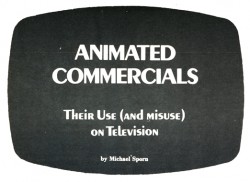 As much as 20 years ago, the animated commercial was fast becoming a viable art form. Bert and Harry Piels and Marky Maypo had already entered our lives via the television spot, and audiences waited through many an hour of mediocre TV presentations to be entertained by such characters in their one-minute commercial messages.
As much as 20 years ago, the animated commercial was fast becoming a viable art form. Bert and Harry Piels and Marky Maypo had already entered our lives via the television spot, and audiences waited through many an hour of mediocre TV presentations to be entertained by such characters in their one-minute commercial messages.
Commercial studios competed with one another to produce higher quality productions and more popular and entertaining films. The studios were major ones employing up to 75 people to produce their work. UPA, Academy, Storyboard, Pelican, and Elektra all existed with creativity and design strongly apparent in their storyboards and continuing right through to their finished product.
There was much experimentation in design and approach. The public readily accepted the new styles which they rarely saw or sought in theatres. (Even the trend setting UFA films of the early 50′s didn’t really receive audience acceptance till the arrival of these commercials.) The workers and producers alike took pride in their commercial product, and the results showed in the finished films.
Needless to say, many things have happened in the past 20 years. TV animation took a turn for the worse. Saturday morning, which had been filled with Mighty Mouse, Winky Dink, and Ruff and Ready filtered into a heyday for revitalized prehistoric monsters sliding across the screen with a superhero or two or seven talking for endless hours. Mind you, nothing moved but the sliding monsters and their mouths, but the networks bought it.
The animated commercial also took a nose dive. Individuals from these large studios began setting up their own one- or two-man studios. Their overhead was lower and, naturally, could come up with a lower bid for the commercials. The larger studios couldn’t compete with them and, as a result, became smaller. Dozens of people were thrown out of work. They were made to fight for freelance work from these small studios, change their careers midstream, or retire from their art. Many a good animator, assistant animator, inker or background artist was lost to the system. The result of underbidding was that the budgets never increased while the cost of animation became prohibitively expensive. The producers were forced to find new methods of presentation to stay alive in the commercial market.
The “classic” commercial became a rarity rather than the norm. Even the time allotted the producer to relay the message was reduced. The spots went from 60 seconds to 30 or even 20. The commercials, like Saturday morning TV, became limited in imagination, if not in animation. The agencies took charge of the writing for all campaigns, and more often than not creativity was lacking by the time the producer-had received the spot. There was too much concern for the statistics of the testing and too little concern for what was entertaining as well as selling. When the storyboard was lacking in creativity, even the most conscientious producer was able to do little more than contribute good production values to the finished spot. The spark had been eclipsed.
It is common knowledge that the film business, particularly animation, has had an inordinately poor first half of 1975. Many an animator, unable to find work at any studio, was ready to move for the sun and retire. There was just too little work on the boards. Agencies were looking for live action; a large number of spots were being sent out of the U.S., and a large number of non-union people were competing with and undercutting the established producers (the agencies didn’t seem to mind the cut in production values if they could get the spots done less expensively). With all of these problems apparent, it seemed difficult to imagine how a production house could, indeed, remain in operation.
Toward mid-year, a number of theatricals began to creep into production: THE METAMORPHOSIS brought a new company, San Rio, into being, while RAGGEDYANN AND ANDY brought a theatrical producer, Lester Osterman, into animation; Ralph Bakshi continued his films, COONSKIN, HEY GOOD LOOK-IN’, and THE WAR WIZARDS, while Alexander Schure brought his college, New York Institute of Technology, into production of the feature TUBBY THE TUBA; a third Charlie Brown feature began production at Bill Melendez’ studio, while the 24th feature, THE RESCUERS, began production at the Disney studio. Business in animation was returning to the theatres, just when it seemed that the animated commercial was hardly capable of supporting any studio.
The Hubley Studio, owned and operated by John and Faith Hubley, was formed from Storyboard, Inc., the company set up by the Hubleys in the early 50′s after John had left UFA and he’d met Faith. Storyboard’s commercial films were unique, clever and consistently high in quality. Marky Maypo’s dialogue still exists in the minds of most of TV’s first generation of viewers. The Hubleys used the commercials to pay for their theatrical ventures. Eventually, they moved almost completely to the production of these personal, theatrical films.
The most recent of these personal films is a 90-minute TV production, produced by CBS. Everybody Rides the Carousel is based on the writings of Erik Erikson, the noted psychologist. The film shows the development of a person in a society. This is, obviously, unique material for animation, not to speak of TV animation. It will be curious to see if any effect will be made on other animated programs.
The Peanuts specials, needless to say, have had a great impact on television animation, if not on all phases of American society. Bill Melendez runs the studio that has been producing these films. His studio has been operating for the last 12 years, but, obviously, never has it been so successful. There have been two feature-length films to spin off the very successful TV specials, and now a third theatrical film is in the works. Curiously enough, the few commercials that move through the studio are Peanuts-oriented. At the moment there are two spots being produced for Japanese television starring Charles Schulz’ characters. The studio, thanks to Peanuts, is able to keep a staff of, at least, 15 people on full time.
Most of the other commercial film producers are beginning to look into theatricals. Phil Kimmelman, producer and executive member of Phil Kimmelman & Associates, continued his use of noted designers (Jack Davis, Mort Drucker and Rowland Wilson, who has become an important mainstay of the studio, had designed ads and episodes of Scholastic Rock) when they commissioned Gahan Wilson to design a Halloween special for television. The prospect never passed the boarding stage, since the money ran out. They are still hoping for a backer.
Other studios such as Zander’s Animation Parlour and Ovation, which normally produce only commercials, (Jack Zander had directed the TV feature The Man Who Hated Laughter, and Ovation is currently making a 10-minute industrial film) have said that they are interested in making theatrical films, but they want to be sure that the budgets are large enough.
The problems involved in searching for theatrical films from the vantage point of a commercial film producer can be best illustrated by demonstrating the situation at Perpetual Motion. Studio heads Buzz Potamkin and Hal Silvermintz openly stated that they want to enter the theatrical market. They have been producing a series of low-budgeted spots for NBC’s network, late-night program Weekend. The show is aired the first Saturday of each month on NBC. Each program incorporates in its schedule one or two animated, editorial cartoons. These are usually satirical comments on some phase of the current news stories. Both producers enjoy doing these films since they’re given a freer rein than they usually have with the commercials. Stylization, story and design all combine to make miniature entertainment films for television. They would like to begin a longer film, but they want to make sure that it’ll be a project they’ll enjoy working on for the year or two it’d take to complete.
Buzz Potamkin left little doubt that he thought the animated commercial was far from dead. He stated that he expects this to be far from Perpetual’s worst year, however, if it weren’t for the Weekend spots and several jobs for NBC Sports (animated spots for Joe Garagiola’s pre-game show), the studio might have had a much poorer year. These short films allowed Perpetual to maintain a staff, however minimal.
Morton and Millie Goldsholl are designers in the Chicago area who operate a studio which includes three full-time animators who are capable of table-top, stop-motion films, as well as cel animation. Morton Goldsholl states that half the studio’s film work is in longer films. They have produced a large body of work with some 12 titles listed among their experimental films. Much time is spent in experimentation, and, consequently, they have developed a “strange optical method” which is called “Lens Star.” The end result is a product which bears a resemblance to the “computer image” but, in fact, retains the warmth of the human touch. This method was used in a title to Earthkeeping, an ecology series. The 60-second title represents the beginning of life to the present ecological dilemma.
The Goldsholls seem to have touched on the best of both worlds, and perhaps this is actually what the majority of the commercial studios would like to strive for. They produce a number of commercials each year while still making the short industrial films. This has kept their studio very busy in the past two years.
Commercials, of course, have not disappeared, nor have they been as poor as this article might have led you to believe. There were a number of well-produced spots within this last year, and most of the studios can admit to a good second half of 1975. At the moment, several of the studios are at peak production.
Zander’s Animation Parlour is New York’s largest commercial producing studio. They are presently able to maintain a staff of 25 people to handle their film production. Jack Zander, a long- time veteran animator, heads the studio since 1970 when his studio, Pelican, closed. A large number of specialized commercial films are produced at Zander’s. The spots for Freakies breakfast cereal, animated by Preston Blair, have achieved quite a bit of success. Each eel is a major rendering effort, being prepared with colored pencils on colored paper and pasted to the celluloid sheets. The same method of rendering was employed in the most recent Vlasic Pickle commercials and the Hanes Sheer Pantyhose ads. The studio artists combined live-action with animation successfully on the spots for Dayton’s, a department store located in Chicago, and in an ad for Texaco.
Perpetual Motion has done a spot for Baggies which they are quite proud of. The commercial was designed by Hal Silvermintz. A recent AT&T corporate spot was designed by Guy Billout and animated by Vinnie Cafarelli and Vinnie Bell. Perpetual also has recently acquired the Schickhaus commercials, and for the past year, they have produced the Hawaiian Punch commercials. With these spots, they had a somewhat interesting problem: they were given an established character and design style and told to continue the series in the same vein. They’ve been successful.
Phil Kimmelman & Associates had a slightly different problem with the Cheeto’s Mouse. They were given these spots several years back. The client had been unhappy with the results he had received from other studios. Kimmelman has had the spots ever since. Bill Peck-man, a designer at the studio and a board member of the group, stated that these spots give them a chance to explore a bit with nuances in character. Since they’ve been handling the character for a while now, they feel that they can have some fun with him.
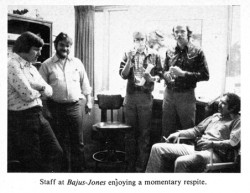 This is all quite interesting when you realize that they have just recently begun producing a number of commercials for Piels Beer which star Bert & Harry Piels.The studio has asked to continue the line of commercials done in the 50′s by UPA. The result was several 30-second spots starring the two characters (once again voiced by Bob and Ray). Kimmelman remarked that he found himself using several of the artists who had worked on the original films (Lu Guarnier had animated the spots at UPA in the 50′s and worked on them again in the 70′s). The only difference between these commercials and the earlier ones is that these are in color.
This is all quite interesting when you realize that they have just recently begun producing a number of commercials for Piels Beer which star Bert & Harry Piels.The studio has asked to continue the line of commercials done in the 50′s by UPA. The result was several 30-second spots starring the two characters (once again voiced by Bob and Ray). Kimmelman remarked that he found himself using several of the artists who had worked on the original films (Lu Guarnier had animated the spots at UPA in the 50′s and worked on them again in the 70′s). The only difference between these commercials and the earlier ones is that these are in color.
Bajus-Jones was formed six years ago in Minneapolis by Mike Jones and Don Bajus. The main office remains in that city, where some 14 people are employed. The studio has representatives in Chicago and New York, and some production is done in New York. Their work has principally been the making of animated commercials—recent commercial productions include a spot for Phillips Petroleum, and one for GMC Truck division— but they are now at work on a pilot for a feature-length film.
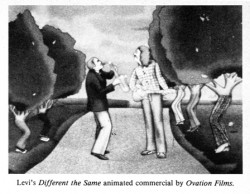 Ovation is owned and operated by Jerry Lieberman, Howard Basis and Art Petricone. Their most recent pride is for a number of spots just completed for Whitman’s Chocolate. The commercials, animated by Doug Crane, are done in the style of the sampler on the box of the chocolates. The end result is an animated crewel that is quite effective. Also of interest from the studio is a Clairol Herbal Essence spot which has a live-action figure walking through an animated garden of earthly delight. This is also the studio that did the campaign for Eastern Airlines. Each commercial incorporates a great number of animated figures. The detail is staggering.
Ovation is owned and operated by Jerry Lieberman, Howard Basis and Art Petricone. Their most recent pride is for a number of spots just completed for Whitman’s Chocolate. The commercials, animated by Doug Crane, are done in the style of the sampler on the box of the chocolates. The end result is an animated crewel that is quite effective. Also of interest from the studio is a Clairol Herbal Essence spot which has a live-action figure walking through an animated garden of earthly delight. This is also the studio that did the campaign for Eastern Airlines. Each commercial incorporates a great number of animated figures. The detail is staggering.
Several studios consider themselves, basically, graphic design studios. The work of the Goldsholls was previously mentioned, though indeed, their commercial work is outstanding. A recent one for 7-Up received well-earned celebrity among TV spots. Their Gillette Right Guard ads employed rotoscoped animation within the graphics. Just recently begun were two fully animated spots for Kellogg, which Morton Goldsholl feels will be a milestone for the studio.
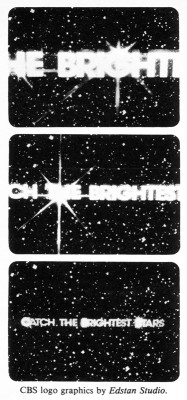 George McGinnis and Mark Howard are the proprietors of the Image Factory. The two producers are designers who would like to see greater use of design and camera in animated films. This approach is, obviously, echoed in their film production. They’ve designed and directed the introductions for the five Mobile Showcase Presentations; (this included the famed TV productions of Moon for the Misbegotten and Queen of the Stardust Ballroom.) They’ve also designed the end logo used in the Metropolitan Life Insurance campaign. They’ve produced the Fall campaign for the CBS-owned and -operated stations. The two producers have a strong interest in moving toward more wholly animated projects, and their final goal will be reached when they can successfully see the combination of animated graphics with in-depth character animation.
George McGinnis and Mark Howard are the proprietors of the Image Factory. The two producers are designers who would like to see greater use of design and camera in animated films. This approach is, obviously, echoed in their film production. They’ve designed and directed the introductions for the five Mobile Showcase Presentations; (this included the famed TV productions of Moon for the Misbegotten and Queen of the Stardust Ballroom.) They’ve also designed the end logo used in the Metropolitan Life Insurance campaign. They’ve produced the Fall campaign for the CBS-owned and -operated stations. The two producers have a strong interest in moving toward more wholly animated projects, and their final goal will be reached when they can successfully see the combination of animated graphics with in-depth character animation.
Edstan is run by Stanley Beck and Ed Feldman. They are a graphics studio which will put the designs brought to them on film. They recently produced the graphics for NBC, CBS and Metromedia’s Fall campaigns. They also produced the opening graphics for the networks’ film programs. The studio has been in operation since 1959 and has produced a large number of network titles (most of the late night movie titles were produced at Edstan.)
With the Cheeto’s mouse, Freakies’ freakies, the Hawaiian Punch character, Vlasic’s stork, and the revival of Bert and Harry, it looks auspiciously as though animated commercials are turning toward the characters to entertain us. Perhaps this will be the trend; the agencies will spend more time caring about the viewer and a lot of good animation will come across the TV sets in America.
